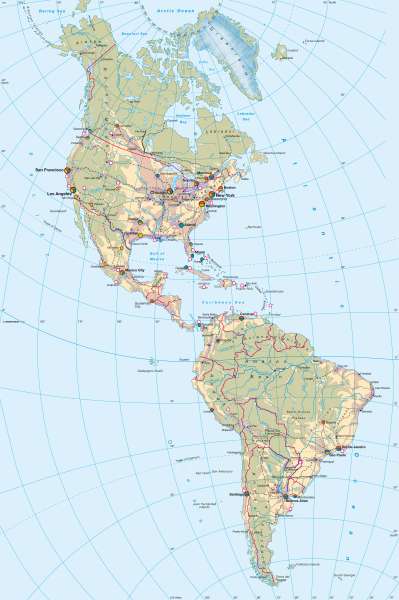Economy (overview)
The Americas - Economy
978-3-14-100790-9 | Page 130 | Ill. 1

Information
Two economic alliances unite the vast majority of America's economic strength: NAFTA (Canada, USA, Mexico) in North America and MERCOSUR in South America (Argentina, Brazil, Paraguay, Uruguay, Venezuela). Mexico provides for its NAFTA membership between Anglo and Latin America, with the capital city as the centre of Central America.The extraordinary dominance of the U.S. economy is shown in the map. The highly compressed north-eastern United States, with the two world cities of New York and Chicago, California, including the world's cities Los Angeles and San Francisco and the Northwest as a high-tech centre, are centres of the world economy. Extensive semi-natural landscapes are typical of the Rocky Mountains. The economic centres in Canada are de facto adherent with the American United States. Huge parts of Canada are sparsely inhabited.
South America is characterised by a pronounced coastal orientation. The east coast between Bahia Blanca and Belém is the most important economic area, complemented by a municipal bond between Caracas and Lima and the agglomeration of Santiago. The opening up of Amazonia along the major rivers and roads (Trans amazônica) reduces the ever present sparsely populated area in the interior.
Economic development of the United States and Canada
The rise of the United States into a leading industrial and technological economy began in the last decades of the 19th Century. Even before the outbreak of World War II, the United States had overtaken the hitherto leading Great Britain with regard to industrial production. Different factors have contributed to the economic success of the country: rich mineral resources, the diverse climate and landscape, a favourable policy environment for business and enterprise, and not least, a fundamentally positive attitude to work, having its roots in the Puritan work ethic of the founding fathers. Silicon Valley in California developed in the postwar period as a centre of world-class innovation, which today accommodates a unique concentration of large computer and information technology companies.
An economic growth region of a very different kind is currently evolving in the Canadian province of Alberta, in which the world's second largest oil reserves, found in huge oil sands reserves, slumber. The exceptionally high energy-consuming dismantling of this particular type of oil has only, in recent years, become economically viable with the sharp increase in world prices of oil. However, it raises a number of questions about its ecological compatibility.
M. Felsch; Ü: Colette Fleming




